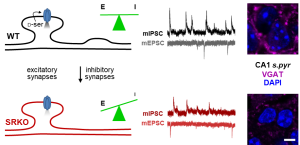Congrats to Shekib for his first Gray Lab publication! There is substantial evidence that both NMDA receptor (NMDAR) hypofunction and dysfunction of GABAergic neurotransmission contribute to schizophrenia, though the relationship between these pathophysiological processes remains poorly understood. Here, we used the serine racemase knockout (SRKO) mice, a model of reduced NMDAR activity in which there is a >90% reduction in the NMDAR co-agonist D-serine. Our results, published in the Journal of Neurophysiology, show a significant reduction in inhibitory synapses onto CA1 pyramidal neurons in the SRKO mice. Using a single-neuron genetic deletion approach, we also found a cell-autonomous loss GABAergic synapses onto pyramidal neurons following SR deletion. These results support a model whereby NMDAR hypofunction in pyramidal cells disrupts GABAergic synapse development leading to disrupted feedback inhibition and impaired neuronal synchrony. Congrats to Shekib Jami and Jon Wong, and thank you to Scott and Emily from Kim McAllister’s lab for the immunohistochemical confirmation of our electrophysiological findings.
Increased excitation-inhibition balance and a loss of GABAergic synapses in the serine racemase knockout model of NMDA receptor hypofunction


